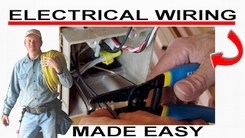» Home Electrical Wiring
» Electrical Wiring Directory
» Generator Transfer Switches and Hook Up Portable Generator
» Need Electrical Help? Ask the Electrician
» Generator Transfer Switches and Hook Up Portable Generator
» Need Electrical Help? Ask the Electrician
Basic Generators

|
Summary: Lets see how a back up generator works and provides power to your home electrical requirements. © By: Dave Rongey |
The Basic Generator System and How It Works
Generator Basics
Generators smaller then 4,000 watts are in most instances not capable of powering a home during a power outage because they can not provide the needed power for electrical loads such as motors, well pumps and ventilation blowers on a central heating system.
Home-Generators
A typical home supplied with 200-amp electric service can actually support a load of approximately 45,000 watts (45kW) of electric demand.
|
Basic Portable Generators Portable generators are produced in sizes ranging from a few hundred watts to 15,000 watts (15kW). Basic Standby Generators A standby generator is a permanently installed generator that is attached to your electrical service panel. Most of the standby generators start automatically and are connected to a large fuel source such as propane or diesel fuel. |
Even if you were to purchase a 10,000 to 15,000 watt portable generator you would find it more expensive, difficult to move, noisy, and the fuel consumption will be large. Typically you will not be able to run you home's central air conditioning system or electric heat pump even with a 15,000 watt portable generator. |
The Safest Way to Test Electrical Devices and Identify Electric Wires!The Non-Contact Electrical TesterThis is a testing tool that I have had in my personal electrical tool pouch for years, and is the first test tool I grab to help identify electrical wiring. It is a Non-contact tester that I use to easily Detect Voltage in Cables, Cords, Circuit Breakers, Lighting Fixtures, Switches, Outlets and Wires. Simply insert the end of the tester into an outlet, lamp socket, or hold the end of the tester against the wire you wish to test. Very handy and easy to use.
The Quickest Way to Check for Faulty Electrical Wiring!The Plug-In Outlet TesterThis is the first tool I grab to troubleshoot a problem with outlet circuit wiring. This popular tester is also used by most inspectors to test for power and check the polarity of circuit wiring. It detects probable improper wiring conditions in standard 110-125 VAC outlets Provides 6 probable wiring conditions that are quick and easy to read for ultimate efficiency Lights indicate if wiring is correct and indicator light chart is included Tests standard 3-wire outlets UL Listed Light indicates if wiring is incorrect Very handy and easy to use.
Strip Off Wire Insulation without Nicking and Damaging the Electric Wire!The Wire Stripper and Wire CutterMy absolute favorite wire stripping tool that I have had in my personal electrical tool pouch for years, and this is the tool I use to safely strip electrical wires. This handy tool has multiple uses: The wire gauges are shown on the side of the tool so you know which slot to use for stripping insulation. The end of the tool can be used to grip and bend wire which is handy for attaching wire onto the screw terminals of switches and outlets.. The wire stripper will work on both solid and stranded wire. This tool is Very Handy and Easy to Use. |
||














